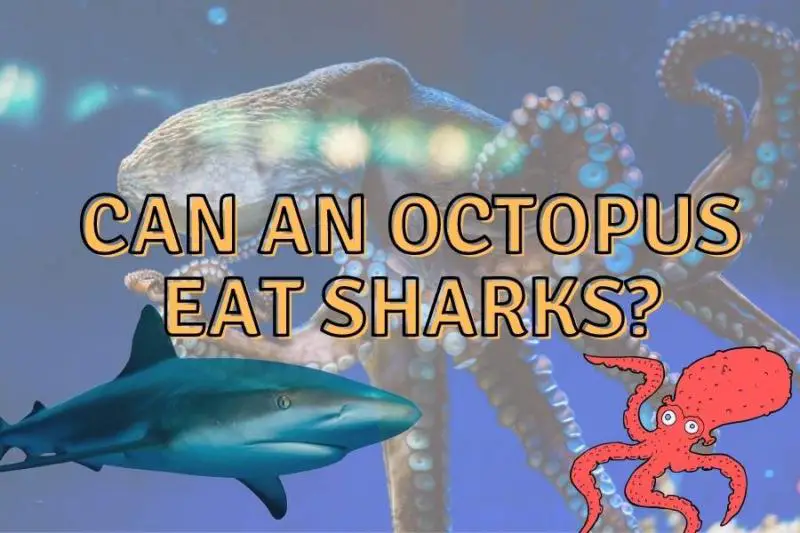Although the shark appears to be indestructible, research has revealed that it does have predators.
Yes, some large octopuses can eat sharks! One of them, the Giant Pacific Octopus, may surprise you! This octopus has adequate size to catch and eat tiny sharks. Whereas sharks and birds are among its prey, shrimp, lobsters, and fish make up the majority of their diet.
Octopuses hunt by scouring the ocean floor for suitable prey. The Giant Pacific octopuses hunt at night and are carnivores.
The Seattle Aquarium was the site of the first documented evidence of an octopus consuming a dogfish, a shark species. These octopuses are themselves eaten by seals, eels, and sperm whales.
Octopuses can be found in every ocean on the planet, as well as along every US coast. Octopuses are found in coastal marine environments and spend a lot of time in dens, which are tiny holes and crevices in rocks and coral.
They are usually solitary and possessive of their territory. However, if they live in regions where sharks also reside, there is a chance that they will defend themselves upon a shark attack or even hunt smaller sharks for food.
How does an octopus catch a shark?
They can sense the scent, texture, and taste of their prey while remaining undetected thanks to sensors situated in each of the suction cups at the bottom of their arms.
The octopus’ famed backward swim is accomplished by blasting water through a muscular tube on its body known as a siphon.
In order to get food, octopuses creep around the ocean floor, tucking their limbs into microscopic spaces. Octopuses are eaten by seals, whales, and huge fish.
Octopuses have exceptional vision. According to scientists, they hunt by first picturing their surroundings and then investigating the area with their arms.
Octopuses lunge to transport prey to their mouths because the suckers are sensitive to taste. Giant Pacific octopuses have demonstrated the capacity to mimic other octopuses and solve mazes, indicating that they are an intelligent species.
After spotting its victim, the octopus strikes in an attempt to capture it. Octopuses often attack their prey from below and drag it into their mouth with powerful suctions that line their eight arms.
The octopus then drags its prey to its crack or cave, where it may be eaten in peace.
All octopus species are venomous to some degree, according to studies, and this has been connected to how they hunt for their food.
When the blue-ringed octopus bites its victim, it injects venom, which causes the animal to become paralyzed. Octopus venom evolved precisely to paralyze crabs fast, which may be deadly due to their big, strong claws. Once prey is captured, the odds of escaping the octopus’ grip are low.
The venom can be pumped into the crab or absorbed via the gills. The octopus’ arms may grow into a tent-like cage, enclosing the crab and concentrating the venom in the water.
Octopus suckers have a powerful enough pull that the water within can cavitate. Even little octopuses may rip open bivalves that refuse to cooperate. Regardless of their size, these cephalopods don’t follow the no-puncture laws. To dig into offenders, an octopus would typically utilize its sharp beak or spiky radula (an anatomical structure used by octopuses for feeding, which resembles a tongue).
The frequency with which octopuses feed is determined by a number of factors, including the time of day, how hungry they are, and the availability of food.
Octopuses are nocturnal feeders, however, some studies, suggest that they can hunt and feed throughout the day if they are hungry and prey is available.
About The Giant Octopuses of the Pacific
The giant pacific octopus is the species most likely to succeed in overcoming a shark and eating it as its food.

Invertebrate cephalopods, giant Pacific octopuses are invertebrates. They may be anywhere from 9 and 20 feet long. They had eight arms, each of which might be 6 feet long. Each arm can have 280 suckers, each with a variety of sensors for sensing its surroundings and prey.
The colossal Pacific octopuses may reach a weight of 150 pounds. Males and females are often of different sizes. Both are available in a variety of colors, ranging from white to coral. They have a brief lifespan of three to five years before reproducing.
Each of the eight limbs of the huge Pacific octopus has 100 to 280 suckers that may be attached independently. Invertebrate cephalopods, giant Pacific octopuses are invertebrates. They may be anywhere from 9 and 20 feet long. They had eight arms, each of which might be 6 feet long.
The Home of the Giant Octopus
The North Pacific giant octopuses are a subspecies of big Pacific octopuses that reside in the northern Pacific Ocean. They live in shallow to deep seas and may be found from Alaska through California to Japan. They favor rocky terrain because it allows them to build dens to protect their eggs. Although population numbers are not available at this time, pollution has an impact on them.
Relationships between Predator and Prey
Giant Pacific octopuses hunt at night and are carnivores. With their beaks, they shred. Sharks and birds are among the prey. Shrimp, lobsters, and fish make up the majority of their food. The Seattle Aquarium was the site of the first documented evidence of an octopus consuming a dogfish, a shark species. These octopuses are eaten by seals, eels, and sperm whales.
Giant Octopus Behavior
Octopuses have exceptional vision. According to scientists, they hunt by first picturing their surroundings and then investigating the area with their arms. Octopuses lunge to transport prey to their mouths because the suckers are sensitive to taste. Giant Pacific octopuses have demonstrated the capacity to mimic other octopuses and solve mazes, indicating that they are intelligent.
Reproduction of the Giant Octopus
In carefully selected dens, female gigantic Pacific octopuses may lay up to 100,000 eggs. These dens may be found in a variety of places, from rocky caverns to flowerpots. Females meticulously care for their eggs, washing them and abstaining from consuming them until they hatch. Males die shortly after mating, whereas females die shortly after the offspring hatch.
Newly born octopuses float in the water for months before settling on the ocean floor and establishing a habitat.
When does an Octopus Eat?
The frequency with which octopuses feed is determined by a number of factors, including the time of day, how hungry they are, and the availability of food. Octopuses are nocturnal feeders, according to research. Other studies, on the other hand, suggest that octopuses can hunt and feed throughout the day if they are hungry and prey is available.
What Hunts The Great Octopus?
Octopuses are eaten by eels, moray, fish, seals, sea otters, a variety of birds, and sperm whales. Octopuses adopt a variety of methods to avoid predators, including adjusting their skin colorfast, making bright displays or ejecting ink to shock or confound predators, squeezing into small cracks to disappear, and quickly propelling themselves through the water.
What other big sea animals do octopuses eat?
Over 300 kinds of octopus have been identified in the world’s waters, according to scientists. Octopi range in size from little to enormous. These species are carnivorous, which means they devour meat as their primary food.
Shrimp, clams, sharks, lobsters, birds, and fish typically are in the octopus’ diet.
Octopuses are eaten by eels, moray, fish, seals, sea otters, a variety of birds, and sperm whales. Octopuses adopt a variety of methods to avoid predators, including adjusting their skin colorfast, making bright displays or ejecting ink to shock or confound predators, squeezing into small cracks to disappear, and quickly propelling themselves through the water.
Does octopuses eat marlins?
No, they won’t normally do that. A marlin is much larger than octopuses and cannot be eaten by them easily. Blue marlins can grow to become more than 12 feet in length and 2,000 lbs in weight. However, we cannot out rule that a large octopus could eat a smaller marlin.
Does octopuses eat tuna?
The octopus is not able to eat tuna because of its large size. The typical size of tuna fish varies depending on the species. The average tuna fish ranges in size from 15 to 40 inches in length and weighs between 10 and 25 pounds.
Does octopuses eat manatees?
The manatee is too large for the octopus to kill and consume. The manatee adults are usually 9 to 10 feet long from nose to tail and weigh approximately 1,000 pounds, although they can grow to be over 13 feet long and weigh over 3,500 pounds.
Do octopuses eat sea lions?
An octopus is unable to eat a sea lion, but the sea lion can eat the octopus. The male sea lion may reach lengths of 11 feet and weights about 2,500 pounds. Females are substantially smaller, reaching a maximum length of 9 feet and a weight of 1,000 pounds.





